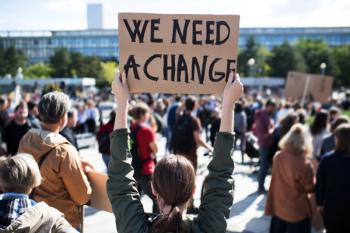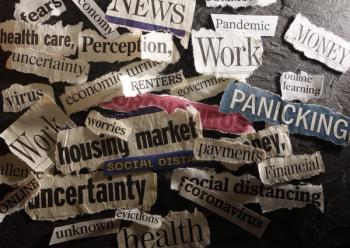
- Vol 39, Issue 2
Malingering as a Maladaptive Pattern of Survival During the Pandemic
Malingering is a common challenge for emergency department clinicians, particularly during the pandemic. Here are 3 cases of COVID-19–induced malingering.
Malingering: The Diagnosis
DSM-5 describes malingering as “the intentional production of false or grossly exaggerated physical or psychological problems.”1 More specifically, malingering is a conscious deceptive behavior employed episodically and opportunistically.2 The feigning, simulation, or exaggeration of symptoms is dimensional and continuous rather than an absolute condition.3 Suspected secondary gains include food and shelter, medications, financial gains, and avoidance of jail, work, or family responsibilities.4 In the absence of traditional and reliable psychiatric symptoms, and given the presence of the manipulative features described, malingering is not always considered a legitimate psychiatric disorder.
Although malingering in psychiatric emergency settings has not been widely studied, colleagues in a New York City academic hospital found that malingering was suspected among one-third of the patients presenting to the psychiatric ED.2 Other assessments in urban psychiatric EDs have suggested that 13% were strongly or definitely suspected of feigning symptoms.4 Malingering also poses a challenge to emergency medicine physicians, who, for example, need to differentiate between patients who need pain medications and those who fabricate pain symptoms to obtain medications.5
A sophisticated psychiatric assessment should differentiate malingering from its often parallel condition factitious disorder, in which deception also occurs voluntarily and consciously. In factitious disorder, however, motivation remains unconscious, with an aim of emotional compensation rather than financial or external advantage.3
Psychiatrists are often insufficiently trained in the assessment of malingering and factitious disorders. They and their staff can become conflicted around its diagnosis and management.6,7 Patients themselves, however, are rarely concerned with diagnostic fine points or validity. When they have needs to fulfill, especially basic needs, that becomes their goal. A psychiatric evaluation aimed at diagnostic clarity fundamentally conflicts with the patient’s goal.8,9
Once malingering has been diagnosed, what is a just course of action during a pandemic? Physicians can empathize with their patient undergoing hard circumstances, but they risk reinforcing maladaptive behavior. Physicians can discharge their patient, but they then risk provoking conflict and even overt aggression.10
Case 1
“John,” a man in his 50s, returned to Connecticut in February 2020 after living elsewhere for years. He had a history of seizure and substance use disorders. Upon his return, he had nowhere to live. John came to our ED reporting seizures; he was noted to be dismissive and uncooperative, which led to a psychiatric referral. Psychiatric staff noted that John’s suicidal plans kept changing from cutting his wrist to stabbing his abdomen with a stick, and then to walking in traffic. The combination of his vague symptoms, confrontational response when asked for details, and lack of a traditional psychiatric history led staff to believe that his main problem was housing. He was held overnight in our observation area due to his general level of distress. John apologized the next morning for his confrontational behavior, showed a complete resolution of symptoms, then requested discharge.
Subsequently, John returned. In fact, after the COVID-19 lockdown, he presented 12 times for complaints including chest pain, seizures, and suicidal ideation. He had only come to the ED twice in the months prior to the lockdown. At his visits before lockdown, he was straightforward and explained that he needed medications for his seizure disorder.
Psychiatry staff—physicians and a licensed clinical social worker (LCSW)—decided to take a different approach at one of his later visits. They realized John was frustrated that the state office closures prevented him from obtaining ID documents, an insurance card, or money, and that the travel restrictions prevented his return to the state where he was living. The psychiatry LCSW gave him a sleeping bag, bus passes, and food, and instructed him to reconnect with a case worker in the community. John returned 2 hours later, after scratching his wrist superficially. In retrospect, it was too late in the day to find a place to bed down. He reconstituted overnight and asked to be discharged in the morning.
John has subsequently returned, but without psychiatric complaints. He has presented 3 times, but only with medical complaints—none requiring an overnight stay.
Case 2
A month into the pandemic, “James,” a middle-aged man, was noted to be loitering in our ED waiting area. Triage staff asked him to register so that he could talk to a social worker. A social worker discovered that James did not have much social support, but, until the pandemic, he had seemingly been able to subsist in the community. A review of his chart revealed a history of substance abuse, homelessness, and legal problems, but no traditional psychiatric history. On interviewing James, the social work department found him to be angry, even talking of killing people. James was referred to the psychiatry ED.
On psychiatric evaluation, instead of being “depressed,” James said that his “father died recently of COVID in Florida.” His affect was not congruent with his story. The psychiatrist also noted that he started asking for admission to the hospital even before the interview was complete. Further into the interview, James threatened to “kill Chinese people,” alluding to the coronavirus originating in Wuhan. Although the psychiatrist doubted the patient’s behavior was the product of mental illness, given the provocative statements, James was kept in the ED for observation overnight. By morning, it became evident that he did not have acute psychiatric symptoms—he did not appear to be in any significant distress. He was laughing with other patients and demanding various things of staff. He was then discharged.
James returned to our ED a few days later, saying he was angry that no one was helping him. Now he threatened to “kill myself or somebody else.” He gave no details and no plan. He was thought to be malingering for housing. He was again discharged.
Similar presentations continued over the next week until he tested positive for COVID-19 (while minimally symptomatic). This test result made him eligible for a designated COVID-19–positive shelter. From there, James was transferred to a government-subsidized hotel room. His ED presentations ceased for 10 days.
Unfortunately, the hotel evicted James when he was reported to be inviting people into his room to use drugs. He then returned to our ED. Upon again being discharged, James declared “If I have to, I will use illegal means to get what I need, and I will keep coming back to the ED.”
Malingering: The Context
Yale New Haven Hospital (YNHH) is a 1500-bed tertiary care medical center that operates 2 EDs in downtown New Haven, Connecticut, handling about 80,000 visits a year. They include psychiatric emergency services (PES) staffed 24 hours a day with locked space for 22 patients with psychiatric issues, plus a locked psychiatric observation unit with capacity for 16 patients.
Connecticut Governor Ned Lamont issued emergency orders suspending nonessential business and ordering residents to stay at home shortly after Connecticut reported its first COVID-19 case on March 8, 2020. YNHH instituted COVID-19–specific triage, admission, and discharge algorithms. It also implemented visitor restrictions, stricter hand hygiene, face masks, and temperature monitoring. Accessibility is inherent to the ED mission: The ED at YNHH did not raise any new barriers to access.
The crisis caused state offices to close, preventing John from Case 1 from obtaining an ID card, Medicaid coverage, funds, work, or housing. It also affected shelter facilities: Services were suspended and patients were referred to (limited) government-subsidized hotel rooms. Opioid treatment programs restricted their services. Community activity programs and soup kitchens cut back to avoid social gathering. All this left both John and James with very few options. These patients came to our ED due to lack of any support—the local social safety net was in tatters.
The individuals in these cases also suffered from the indirect effects of business closures. People in the community were now unable to support others in need. There was growing fear of viral contagion. Some families shut out their own family members out of fear that elderly parents were at risk. Patients with unstable housing who used to fall back on family in the past were now literally left out in the cold.
Fundamentally, these patients were seeking shelter in our ED because of the pandemic. Despite our efforts as psychiatrists to be helpful, we were not effective because these patients were not seeking psychiatric help. When John was given concrete assistance (bus passes, sleeping bag), it reduced some of his need for the ED. Of note, once rested and fed, both patients exercised enough self-control to obtain their discharge, use drugs, and start all over again. Substance cravings motivated more of their behavior than we realized at the time. Staff became so frustrated that one typed, “Inappropriate use of mental health resources during time of a health crisis is an unacceptable way of getting his needs met,” in John’s record.
Malingering: The Countertransference
ED physicians may be more sympathetic to misadventures than they may realize. How else could they minister to daily mistakes and mishaps with sharp instruments and power tools? However, they were impotent to reintegrate these patients into a community wracked by a pandemic. ED staff became frustrated with both patients, in part because their interventions were failing. There was a sense of relief in the morning when the patients wanted to go, but there was a sense of defeat when the patients returned. Frustration is particularly difficult to manage when staff feel overwhelmed, and COVID-19 overwhelmed the entire health system. Staff were left struggling and uncertain about protective equipment and the constantly changing clinical guidelines. Malingering thus becomes especially aggravating.
Cases such as these are difficult even before the diagnosis is made. Efforts at evaluation will flounder and frustrate staff who initially presume a traditional patient commitment to truth in pursuit of diagnosis and treatment. In an ED, there is no preexisting patient-doctor relationship. There is nothing to bridge the gap between staff and patient.11 After the diagnosis has been made, staff feel a pull to collude with the patient to satisfy real needs. On the other hand, there is a push toward confrontation to conserve and fairly distribute scarce resources, especially during a pandemic. Consciously pursuing a balance between the pull and the push may help staff avoid burnout, if not be more concretely helpful.
Malingering: The Deal
Where but in the United States is there an urban society without a secure social safety net that also offers “intensive medical services” all day and night for all comers? Lack of a social alternative doubly strains the overwhelmed US health care system. For such patients, a PES or general ED is not a health care facility—it is simply a potential source of food, accommodation, psychoactive substances, or something else whose lack has become critical, especially during a disaster. In the words of an ED social worker, “An ED is a 24-hour social service agency.”
Before the pandemic, we had an equilibrium. We had an implicit deal: “We’ll give you a hand with food and shelter during this cold night, but you leave in the morning.” In point of fact, hospitals are usually paid whether or not a patient is malingering. Other, more legitimate diagnoses may justify the charges (eg, adjustment disorder or substance-induced mood disorder).
The equilibrium was also changed by reduced utilization of emergency services and hospitalization. Even patients with strokes and heart attacks avoided hospitals out of fear of COVID-19 in the early stages of the pandemic.12 Preliminary assessments in our health system suggest a decline of 30% of psychiatric ED visits during the first weeks of the pandemic.13 This pandemic challenged physicians to revisit their ideology, convictions, and values, consciously or unconsciously.
Case 3
“He is full of it, doctor,” the triage nurse announced when this patient presented. “Jack” was in his 20s and originally from the West Coast. He had come to the psychiatric ED’s attention 3 days after he arrived downtown on a train from New York City. Prior to the pandemic, he had survived in New York City for 8 months by panhandling. Now, from our town green, he called 911 to report a man having a seizure. EMS deduced that he was calling about himself during the so-called seizure. They brought Jack to our ED anyway because he told them he was homeless and sad and wanted to talk to someone.
During the psychiatric assessment, he was dismissive, vague, and very inconsistent. “Can’t you tell that I’m hearing voices?” Jack said while covering his face with a blanket. After resting for 5 hours, he was discharged.
Three hours later, after the sun had set, police brought him back to the ED; this time, it was from the train station where he was found naked, threatening to rape people. During a psychiatric evaluation, he said that if discharged, he was going to rob stores so that he could land in jail rather than remain homeless. The next morning, in the absence of behavioral problems, he was discharged again with a diagnosis of malingering.
Two hours later, he was arrested and taken into police custody. Jack explained that he had stolen a knife from a drugstore and attempted to rob 2 downtown restaurants. This time, our interviewer noticed significant disorganization. Jack was upset and paranoid about New York City and about his family. He was only happy that he had been arrested because he would be safe in jail; in fact, he was asking to be discharged to jail.
A call to Jack’s mother revealed a diagnosis of schizophrenia. She also described methamphetamine-use disorder starting at age 16, and more recent synthetic marijuana use. With this information, it seemed more appropriate to involuntarily admit the patient to a psychiatric facility. COVID-19 testing was negative.
Malingering and psychiatric illness can coexist and often do. Our clinicians had to see past the malingering to recognize psychotic and substance use disorders. What is also interesting is the way in which the pandemic disrupted Jack’s habitat, prompting him to board a train as far as he could easily travel. He was even more poorly adapted to these new circumstances and fell into malingering.
Concluding Thoughts
It is important to see beyond patients’ deceptions to identify solutions to real problems while assessing and treating malingering patients in the context of a natural disaster. This challenge is compounded by negative countertransference, if only from added work, combined with manipulation. Physicians may need to walk a fine line between collusion and confrontation.
More studies of the malingering patient in the ED might be helpful. An institutional approach or a policy may facilitate the management and hopefully decrease the frequency of the maladaptive behavior.10 All these efforts would help ED staff; they may help decrease the time spent with these patients and may reduce frustration or burnout.
This COVID-19 pandemic presents an unexpected opportunity to observe behavioral adaptation to crisis and to consider the medical-ethical dilemmas that arise. Focusing on patients who malinger highlights subtle issues of justice and beneficence and challenges us to avoid overcompensation and generalization in our response.
Malingering is not a distinctively different phenomenon during the pandemic. However, this pandemic has been a distinct precipitant––of scarce resources, governmental restrictions, and fear of infection. Patients and ED staff are all on edge, which affects decision-making and ultimately clinical outcomes.
Dr Matos Santana is an assistant professor of psychiatry at Yale School of Medicine in New Haven, Connecticut, and physician lead for Psychiatric Emergency Services at Yale New Haven Hospital. Dr Goldenberg is an associate professor of psychiatry at Yale School of Medicine and co-director of the Medical Student Clerkship, Biopsychosocial Approach to Health-Psychiatry, Psychiatry. Dr Powsner is a professor of psychiatry and emergency medicine at Yale School of Medicine and director of the Crisis Intervention Unit at Yale New Haven Hospital.
References
1. American Psychiatric Association.
2. Rumschik SM, Appel JM.
3. Ford C, Sonnier L, McCullumsmith C.
4. Yates BD, Nordquist CR, Schultz-Ross RA.
5. Hansen GR.
6. Beach SR, Taylor JB, Kontos N.
7. Zubera A, Raza M, Holaday E, et al.
8. Petrik ML, Gutierrez PM, Berlin JS, Saunders SM.
9. Malone RD, Lange CL.
10. Taylor JB, Beach SR, Kontos N.
11. Powsner S.
12. Pines JM, Zocchi MS, Black BS, et al.
13. Goldenberg MN, Parwani V.
Articles in this issue
almost 4 years ago
New Directions for Insomnia and Bipolar Disorderalmost 4 years ago
A Simple Concept With Complex Implicationsalmost 4 years ago
Spotlight on Issues in ADHDalmost 4 years ago
To Disclose or Not to Disclose? Lessons From a Dying Therapistalmost 4 years ago
Dress Rehearsalalmost 4 years ago
Clozapine: Increased Risk of COVID-19 Severity?almost 4 years ago
10 Factors to Consider When Cross-Titrating Antipsychoticsalmost 4 years ago
Looking to the FutureNewsletter
Receive trusted psychiatric news, expert analysis, and clinical insights — subscribe today to support your practice and your patients.














